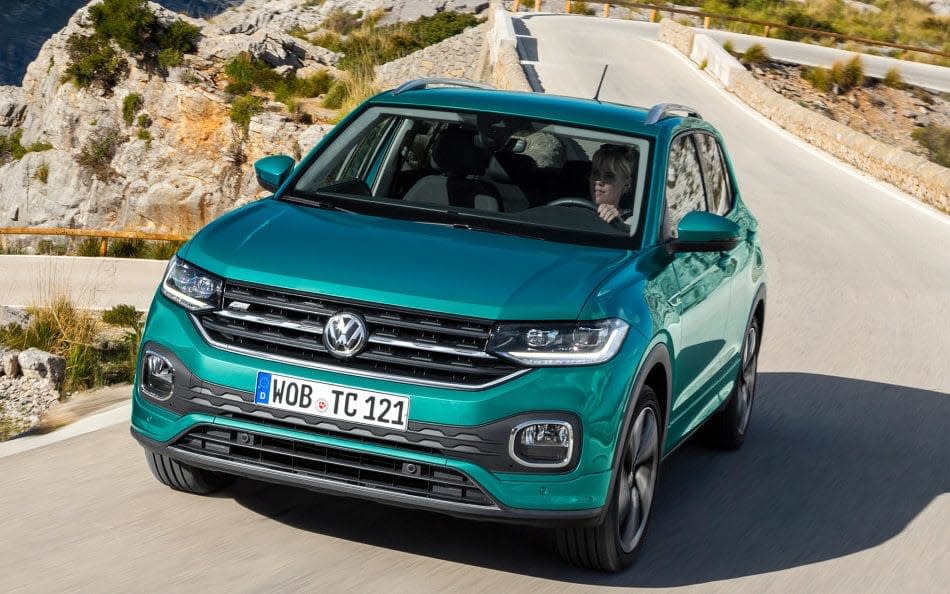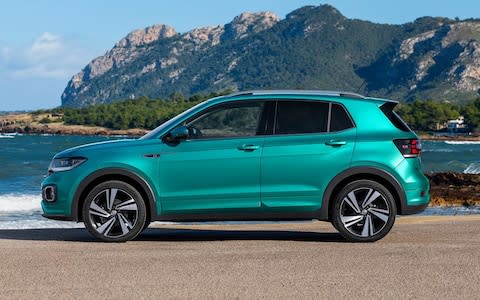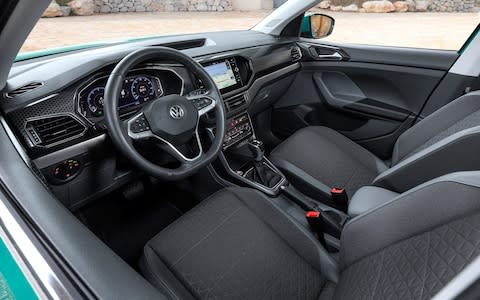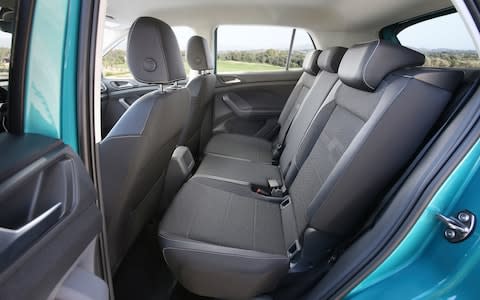Volkswagen T-Cross review: more than another jacked-up supermini looking for a field to get stuck in?

There are a lot of Renault 4s on the island of Mallorca, where Volkswagen chose to launch its new Polo-based SUV/crossover the T-Cross; comparisons were irresistible. Credited as being the first mass-production hatchback, the French firm’s front-engined, front-drive competitor to Citroën’s 2CV and VW’s Beetle had an innovative, all-independent torsion-bar suspension system which could be adjusted in minutes to provide higher ground clearance.
Tough, long-lasting and comfortable, the R4 was a progenitor for the modern crossover, of which the T-cross is the latest example.
I’m not sure whether history will judge the T-Cross as kindly; these small front-drive crossovers are an exploding market, but one can’t help thinking they are much ado about nothing, just a series of jacked-up superminis looking for a field to get stuck in.
The T-Cross, for example, is based on a VW platform which underpins just about everything in the VW Group canon with driven front wheels. So that's MacPherson struts at the front, with a torsion beam rear suspension. It’s built on VW’s Polo production line in Pamplona, Spain and is the fifth VW-badged SUV under the Touareg, Tiguan All Space, Tiguan and T-Roc, the last of which is selling like spectacularly in the UK and Europe as a whole.

At 4,107mm long, T-Cross is 54mm longer than the Polo and runs on wheel and tyre combinations about an inch larger in diameter. It seats four six-foot adults in comfort, with a sliding rear seat which means boot space varies between 385 and 455 litres (along with the rear leg room, of course).
From launch there will be two 1.0-litre, turbocharged, three-cylinder petrol engines, developing 94bhp or 113bhp. The former comes with a five-speed manual gearbox, the latter with a choice of six-speed manual or seven-speed, dual-clutch DSG. They’re all front-wheel drive and there’s no 4x4 option or enhanced traction software as found on some Peugeot and Fiat rivals.
The 94bhp model accelerates from 0-62mph in 11.5sec, with a top speed of 112mph, the 113bhp model has equivalent performance of 10.2sec/120mph, and VW claims that that both are capable of delivering 57.7mpg on the NEDC cycle. However, like most of the latest small-capacity, three-cylinder turbo units they don't fare so well on the new WLTP cycle which will form the basis of new-car VED from April next year; we managed respectively 38.2mpg and 35.8mpg driving briskly but far from madly around the roads of Majorca.

VW’s 148bhp, 1.5-litre, four-cylinder turbo petrol will be eventually offered; given the small - and declining - sales for diesel in this market, there will be no oil-burning option.
It’s not quite the smallest one of an identical series of Russian SUV dolls, but it looks pretty close to its big sisters at the front, with big goggle-eyes chromium rims around the fog lamps. The rest of it is slick and instantly forgettable.
The cabin presents a mix of practical and well made, but with inexpensive materials linking VW parts bin assemblies such as the centre touchscreen - materially the Golf and Polo far surpass the T-Cross. Higher spec models might have up to four USB charge plugs, but on all models the boot floor is bendy, doesn’t fit too well and taking it out to reveal the (empty) spare wheel well is a two-handed job.
The rear seat backs fold on to the sliding bases 60/40 per cent, but the resulting load space isn’t entirely flat.

All models get height-adjustable driver and passenger seats and the driving position is reasonably comfortable for most sizes of drivers. There’s a fair bit of room around the seats and decent-sized door pockets, although the lidded centre console is tiny and the glovebox is filled by the owner’s manual.
The instrument binnacle is clear with a 40-watt version of Audi’s virtual dashboard on better-specced models and the latest VW Group touchscreen, thankfully now with separate rotary volume and zoom buttons. Graphics are precise and voice instructions clear, though our system took exception to the Balearic island and refused to find the hotel. While clearly built down to a price, the facia of upper-spec models can be jollied up with coloured panels and coloured seat trim.
Safety consists of all the camera- and radar-based autonomous braking and pedestrian recognition systems together with intelligent cruise control and blind-spot monitoring. Apple CarPlay and Android Auto are standard on all except the base S model, where you can have one but not the other, which seems weird.

Key or push-button start? It’s one of the defining points on the modern trim hierarchy although at least turning a key gives you somewhere to put it where it isn’t going to sing along with the vehicle’s natural frequencies.
Both engines sound similar, as if the Tin Man had swallowed his electric toothbrush, though the 94bhp model feels flat with less pulling power so you need to use the gearbox more, which isn’t great as both gearboxes have very high top gears, with too widely stacked ratios and pretty terrible linkages, as clanky as that old mechanical arrangement on the Renault 4 - the excellent dual-clutch semi-automatic gearbox adds £1,500 to the price.
The 114bhp model will be the most popular and rightly so, it’s got more vim in the middle range and although it only revs to 6,000rpm (unlike the 94bhp unit’s 6,500rpm) neither does much work above 5,000rpm so it doesn't matter much.
Even on the 18-inch wheels of the launch cars, the ride is sensational, with a progressive body control that laughs at sleeping policeman and irons out bumps and potholes - pretty much like a Renault 4, then.

But in this case, the chassis has more than one dimension. Speed up and while the body rolls into corners it’s finely judged and nicely limited. The steering is over assisted, but accurate with a good weight. You don’t float along the road in the T-Cross, but you are never less than comfortable and confident at the wheel. And for those rare individuals who want to drive it hard, T-Cross will point its nose back into the apex at the ease of the throttle pedal; it’s not fun, but it’ll do it.
I wish VW had put a bit more love into the cabin - and I’m still not sure why the world is clamouring for these small crossovers which are significantly larger than the nippy little hatchbacks they replace.
Against its rivals, however, VW’s T-Cross is well judged, big enough to be a family car, seems well made and is supremely comfortable. I think they are going to sell these by the bucket load although, if you’ll excuse me, I’d rather have a classic Renault 4.
THE FACTS
VW T-Cross 1.0 TSI 115PS
TESTED 999cc, three-cylinder turbo petrol engine, six-speed manual gearbox (seven-speed twin-clutch semi-auto a £1,500 option), front-wheel drive
PRICE/ON SALE range from £17,940 to £22,695 (£23,550 as tested in R-line trim)/now with first deliveries in April
POWER/TORQUE 113bhp @ 5,000rpm, 148lb ft @ 2,000rpm
TOP SPEED 120mph
ACCELERATION 0-62mph in 10.2sec
FUEL ECONOMY WLTP 48.3mpg Combined, 35.8mpg on test
CO2 EMISSIONS NEDC 112g/km, WLTP 132g/km
VED £170 first year, then £140
VERDICT This decent looking and commodious baby SUV/crossover from the VW stable beats rivals hands down in ride comfort and body control, but the three-cylinder engines are a lot less economical than their NEDC figures, the manual gearboxes aren’t great and the cabin trim is cheap.
TELEGRAPH RATING Four stars out of five
THE RIVALS
Peugeot 2008, from £17,424
One for the first supermini crossover SUVs and now getting long in the tooth. Only the designer's mother could love it, but this little pug is good to drive, with a well-designed cabin and has an economical range of engines starting with the 1.2-litre three-cylinder.
Fiat Panda 4x4, from £16,360
Strangely not considered a crossover, but the 4x4 version is vastly more accomplished. Good to drive, charming if a bit Spartan inside, with off-road agility (thanks to its small size and low weight) which would shame a Range Rover. Best is the 1.3-litre diesel, but the Twin-Air petrol is adequate.
Renault Captur, from £15,300
Derived from Renault's 2011 concept Frendzy, Captur is built down to a price and into a market. Now in its Mark II form, it has perky looks, a decent range of engines and good dynamics, shame is, however, it still rides like a trolley jack.
Suzuki Jimny, from £12,999
It starts and ends here if you want to go somewhere they haven't built a road in a titchy car. The Jimny is cramped, noisy, it bounces along the road and its handling is limited and crash performance questionable, but its 1.3-litre petrol engine is game and it looks beyond cute.
For tips and advice, visit our Advice section, or sign up to our newsletter here
To talk all things motoring with the Telegraph Cars team join the Telegraph Motoring Club Facebook group here

 Yahoo News
Yahoo News 
